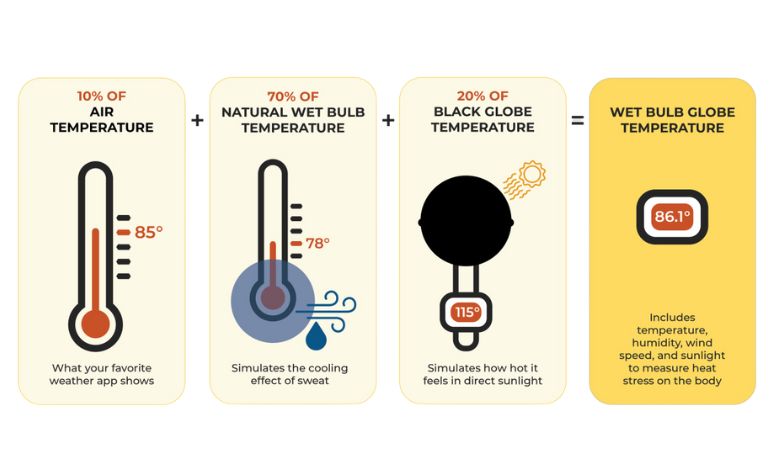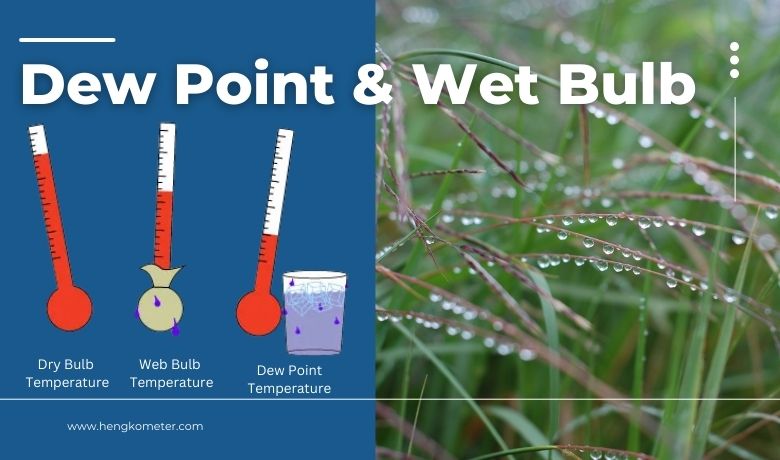Dew point and wet bulb temperature are two crucial measurements that provide valuable insights into the moisture content of air. While they may seem like technical terms, understanding their meaning unlocks a deeper comprehension in various fields, including:
- Weather forecasting: These measurements help predict phenomena like fog formation, precipitation, and humidity levels, enabling accurate weather forecasts.
- Agriculture: Knowing the dew point is vital for farmers to assess crop health and potential risks of diseases caused by excessive moisture.
- HVAC systems: Dew point and wet bulb temperature play a key role in designing and operating efficient air conditioning and dehumidification systems.
- Human comfort: These measurements influence how we perceive temperature. High humidity combined with high temperature can lead to discomfort, while understanding these factors helps create comfortable indoor environments.
Each term and its significance:
- Dew point: Imagine cooling the air at a constant pressure. The dew point is the temperature at which water vapor in the air condenses, forming dew or fog. Higher dew points indicate more moisture in the air, and knowing this helps predict fog formation and potential precipitation.
- Wet bulb temperature: This temperature represents the lowest an air parcel can be cooled through evaporation. It’s measured using a thermometer wrapped in a wet cloth. As water evaporates from the cloth, it cools the thermometer, and the wet bulb temperature reflects the combined effect of air temperature and humidity.
By understanding the relationship between these measurements and their impact on various processes, we gain valuable insights into weather patterns, agricultural practices, efficient building management, and even our own comfort levels.
Dew point temperature, simply put, is the “magic number” for moisture in the air. It’s the crucial temperature at which the air becomes saturated with water vapor, and condensation begins to occur, forming dew, fog, or frost. Imagine leaving a cold drink outside on a humid day; water droplets form on the outside when the drink reaches the dew point temperature of the surrounding air.
Dew point acts as a key indicator of atmospheric moisture because it directly reflects the amount of water vapor the air can hold at a specific temperature. Higher dew points signify air laden with more moisture, while lower dew points indicate drier air.
Understanding the relationship between dew point and air humidity is essential:
- Relative humidity: This percentage expresses how much moisture the air currently holds compared to its maximum capacity at that temperature. When the dew point and air temperature are equal, the relative humidity reaches 100%, signifying saturation and the potential for condensation.
- As the dew point rises: This suggests the air is holding more moisture, even if the relative humidity remains constant. This scenario often leads to feelings of mugginess and discomfort, especially on hot days.
Dew point significantly impacts weather patterns and human comfort in various ways:
- Fog formation: When the air temperature cools down to the dew point at night, water vapor condenses, forming fog.
- Precipitation: Rising dew points can contribute to cloud formation and precipitation, influencing weather forecasts.
- Human comfort: High dew points combined with high temperatures can make the air feel muggy and uncomfortable, hindering our ability to sweat and regulate body temperature. Conversely, low dew points in conjunction with cold temperatures can make the air feel dry and crisp.
By understanding dew point, we gain valuable insights into weather patterns, anticipate potential weather events, and dress appropriately for the perceived comfort level based on the prevailing moisture content in the air.
Part 2: What is Wet Bulb Temperature?
Wet bulb temperature reflects the lowest temperature achievable through evaporation under specific atmospheric conditions. It’s measured using a special thermometer with a wetted wick wrapped around its bulb. As air flows past the wick, water evaporates, causing the bulb to cool. The wet bulb temperature is the equilibrium temperature reached when the rate of heat gain from the air equals the rate of heat loss due to evaporation.
The significance of wet bulb temperature lies in its ability to reveal how effectively evaporation can cool the air:
- Higher wet bulb temperatures: Indicate limited evaporative cooling potential. This scenario often occurs in high humidity environments where the air is already saturated with moisture, making it difficult for additional water to evaporate.
- Lower wet bulb temperatures: Conversely, signify greater potential for evaporative cooling. This scenario typically occurs in drier environments where the air readily absorbs moisture from the wick, leading to more effective cooling.
Understanding wet bulb temperature has real-life implications for heat stress and human comfort:
- Heat stress: When both air temperature and wet bulb temperature are high, the body’s ability to cool down through sweating is hampered. This can lead to heat stress, exhaustion, and even heatstroke, especially during strenuous activities.
- Human comfort: Wet bulb temperature plays a crucial role in determining how comfortable we feel in a particular environment. Even at moderate air temperatures, high wet bulb temperatures can make the air feel muggy and uncomfortable due to the limited evaporative cooling effect.
Therefore, monitoring wet bulb temperature alongside air temperature provides a more comprehensive picture of the thermal environment and its potential impact on human health and comfort. This information is valuable for various applications, including:
- Workplace safety: Assessing heat stress risks for outdoor workers and implementing appropriate precautions.
- Athletic training: Optimizing training conditions to prevent heat-related illnesses in athletes.
- Building design and operation: Designing and operating air conditioning systems that effectively manage both temperature and humidity for optimal comfort.
By understanding the concept of wet bulb temperature, we gain a deeper appreciation for the complex interplay between temperature, humidity, and their combined influence on our well-being and the surrounding environment.

Part 3: Dew Point vs. Wet Bulb Temperature - The Differences
While both dew point and wet bulb temperature offer valuable insights into air moisture, they represent distinct concepts with unique implications:
Key Differences:
| Feature | Dew Point | Wet Bulb Temperature |
|---|---|---|
| Definition | Temperature at which air becomes saturated and condensation occurs | Lowest achievable temperature through evaporation under specific conditions |
| Measurement | Indirectly calculated from temperature and humidity | Measured using a thermometer with a wetted wick |
| Indication | Absolute moisture content in the air | Evaporative cooling potential of the air |
| Impact on Weather | Influences fog formation, precipitation | No direct impact, but indirectly affects heat index |
| Impact on Comfort | High dew point = muggy feeling, low dew point = dry feeling | High wet bulb temperature = limited cooling, low wet bulb temperature = effective cooling |
Relationship to Air Moisture:
Both dew point and wet bulb temperature are indirectly related to the absolute amount of moisture in the air. However, they capture different aspects of this moisture:
- Dew point: Reflects the maximum amount of moisture the air can hold at a specific temperature before condensation occurs. Higher dew points indicate more moisture-laden air.
- Wet bulb temperature: Doesn’t directly measure moisture content but indicates how readily the air can absorb additional moisture through evaporation. Lower wet bulb temperatures suggest drier air with greater capacity for evaporation.
Visualizing the Relationship:
A psychrometric chart effectively illustrates the relationship between dew point, wet bulb temperature, and relative humidity:
On the chart:
- Diagonal lines: Represent lines of constant wet bulb temperature.
- Vertical lines: Represent lines of constant dew point.
- Curves: Represent lines of constant relative humidity.
Interpreting the chart:
- A point on the chart represents the current state of the air based on its dry bulb temperature, wet bulb temperature, and relative humidity.
- Following a horizontal line from the dew point value indicates the corresponding relative humidity.
- Following a vertical line from the wet bulb temperature value indicates the corresponding relative humidity.
Understanding these relationships is crucial for interpreting weather forecasts and predicting human comfort levels. For example, a high dew point combined with a high wet bulb temperature suggests very humid air with limited evaporative cooling potential, leading to a feeling of mugginess and discomfort.
By appreciating the distinct roles of dew point and wet bulb temperature, we gain a more comprehensive understanding of the interplay between temperature, humidity, and their combined impact on various aspects of our lives.
Part 4: Applications
Understanding dew point and wet bulb temperature extends beyond theoretical knowledge; they play crucial roles in various practical applications:
Weather Forecasting:
- Predicting fog formation: High dew points combined with falling temperatures indicate a higher likelihood of fog formation at night.
- Assessing precipitation potential: Rising dew points can contribute to cloud formation and precipitation, aiding in more accurate weather forecasts.
- Calculating heat index: Wet bulb temperature is incorporated into the heat index calculation, which reflects how hot it actually feels due to the combined effects of air temperature and humidity. This information is crucial for issuing heat advisories and warnings.
Agriculture:
- Optimizing irrigation: Knowing the dew point helps farmers assess the need for irrigation by considering the existing moisture content in the air. Higher dew points suggest less moisture is lost through evaporation, potentially reducing irrigation requirements.
- Protecting crops from frost: Monitoring dew point allows farmers to anticipate frost events and take preventative measures to protect their crops, such as using frost protection techniques.
HVAC Systems:
- Designing efficient air conditioning systems: Dew point plays a vital role in designing air conditioning systems. By considering the dew point, engineers can determine the appropriate cooling capacity and dehumidification capabilities needed to maintain comfortable indoor conditions.
- Optimizing building energy efficiency: Understanding the relationship between dew point and wet bulb temperature allows for optimizing air conditioning and heating systems to achieve desired comfort levels while minimizing energy consumption.
Public Health:
- Preventing heat-related illnesses: Wet bulb temperature plays a crucial role in assessing heat stress risks. High wet bulb temperatures combined with high air temperatures can significantly limit the body’s ability to cool down, increasing the risk of heatstroke and other heat-related illnesses. Public health advisories and recommendations are often issued based on heat index calculations that incorporate wet bulb temperature.
By understanding the practical applications of dew point and wet bulb temperature, we can appreciate their significant impact on various aspects of our lives. From weather forecasting and agricultural practices to ensuring comfortable living environments and safeguarding public health, these measurements play a vital role in making informed decisions and promoting well-being.
Part 5: Measuring Dew Point and Wet Bulb Temperature
Understanding dew point and wet bulb temperature is valuable, but their practical application requires knowing how to measure them. Here, we explore the tools and methods used:
Measuring Dew Point:
- Direct measurement: Electronic hygrometers directly measure dew point using a chilled mirror or sensor that detects the temperature at which condensation occurs.
- Indirect measurement: This method involves measuring dry bulb temperature and relative humidity using a psychrometer or combination instrument. Dew point can then be calculated using various formulas or psychrometric charts.
Measuring Wet Bulb Temperature:
- Sling psychrometer: This traditional instrument consists of two thermometers, one dry and one with a wick saturated with water. By whirling the psychrometer, air flows over the wet bulb, causing evaporation and lowering its temperature. The difference between the dry and wet bulb temperatures is used to calculate the wet bulb temperature using psychrometric tables or charts.
- Assmann psychrometer: This more advanced instrument uses forced ventilation to achieve a more accurate and consistent measurement of the wet bulb temperature.
- Electronic psychrometers: These instruments combine electronic sensors to measure dry bulb temperature, humidity, and sometimes directly calculate wet bulb temperature.
Psychrometric Chart:
The psychrometric chart is a graphical tool that helps determine dew point and wet bulb temperature from other known parameters like dry bulb temperature and relative humidity. It consists of a series of curves and lines representing various combinations of these variables.
Using the Psychrometric Chart:
- Locate the point on the chart corresponding to the measured dry bulb temperature on the horizontal axis.
- Follow a vertical line upwards from this point until it intersects the curve representing the measured relative humidity.
- The dew point can be found by following a horizontal line from the intersection point towards the left axis.
- The wet bulb temperature can be found by following a diagonal line downwards from the intersection point towards the left axis.
Benefits of the Psychrometric Chart:
- Provides a visual representation of the relationships between dry bulb temperature, wet bulb temperature, dew point, and relative humidity.
- Allows for quick estimation of dew point and wet bulb temperature from readily available measurements.
- Offers valuable insights into the thermodynamic properties of air for various applications.
By understanding the tools and techniques for measuring dew point and wet bulb temperature, along with the utility of the psychrometric chart, individuals can gain valuable insights into the moisture content of the air and its implications for various aspects of their lives.
Part 6: FAQ.
Q: Why do dew point and wet bulb temperature matter?
A: These measurements offer valuable insights into the moisture content of the air, impacting various aspects of our lives:
- Weather forecasting: They play a crucial role in predicting fog formation, precipitation potential, and heat index, leading to more accurate forecasts.
- Agriculture: Understanding these helps farmers optimize irrigation needs, protect crops from frost, and assess crop health.
- HVAC systems: They are essential for designing efficient air conditioning and heating systems, ensuring comfort and minimizing energy consumption.
- Public health: Wet bulb temperature is crucial for assessing heat stress risks and preventing heat-related illnesses.
Q: How do they affect weather forecasts?
A: Dew point and wet bulb temperature influence weather forecasts in several ways:
- Dew point: High dew points indicate higher moisture content, increasing the likelihood of fog formation at night and contributing to cloud formation and potential precipitation.
- Wet bulb temperature: It is incorporated into the heat index calculation, reflecting how hot it feels due to the combined effects of air temperature and humidity. This information is crucial for issuing heat advisories and warnings.
Q: What are the safety thresholds for human health?
A: Wet bulb temperature plays a significant role in assessing heat stress risks. While there’s no single universal threshold, the National Oceanic and Atmospheric Administration (NOAA) considers the following:
- Moderate risk: Wet bulb temperature of 64-74°F (17.8-23.3°C)
- High risk: Wet bulb temperature of 74-79°F (23.3-26.1°C)
- Extreme risk: Wet bulb temperature above 79°F (26.1°C)
These thresholds can vary depending on factors like age, health conditions, and acclimatization. It’s crucial to stay informed about heat advisories and take necessary precautions to avoid heat-related illnesses, especially during periods with high wet bulb temperatures.
Conclusion
Throughout this exploration, we have delved into the fascinating world of dew point and wet bulb temperature, uncovering their distinct roles in understanding the moisture content of air and its impact on various aspects of our lives.
Key Takeaways:
- Dew point: Reflects the “tipping point” for moisture in the air, indicating when condensation occurs and influencing weather patterns like fog formation and precipitation.
- Wet bulb temperature: Represents the lowest achievable temperature through evaporation, providing insights into the evaporative cooling potential of the air and impacting human comfort levels.
Understanding the differences between these two measurements is crucial for:
- Interpreting weather forecasts: Predicting potential for fog, precipitation, and heat stress.
- Optimizing agricultural practices: Managing irrigation needs and protecting crops from frost damage.
- Designing efficient HVAC systems: Ensuring comfort and minimizing energy consumption in buildings.
- Safeguarding public health: Assessing heat stress risks and preventing heat-related illnesses.
Moving forward, consider monitoring these measurements:
- Weather forecasts: Stay informed about dew point and heat index values to plan outdoor activities accordingly.
- Personal comfort: Utilize dew point and wet bulb temperature readings to adjust thermostat settings and clothing choices for optimal comfort.
- Professional applications: For those involved in weather forecasting, agriculture, or HVAC system design, a deeper understanding of these measurements is essential for informed decision-making.
By appreciating the significance of dew point and wet bulb temperature, we gain valuable knowledge that empowers us to navigate the complexities of our environment, ensuring optimal comfort, efficient resource management, and ultimately, a deeper appreciation for the intricate interplay between moisture and the world around us.






